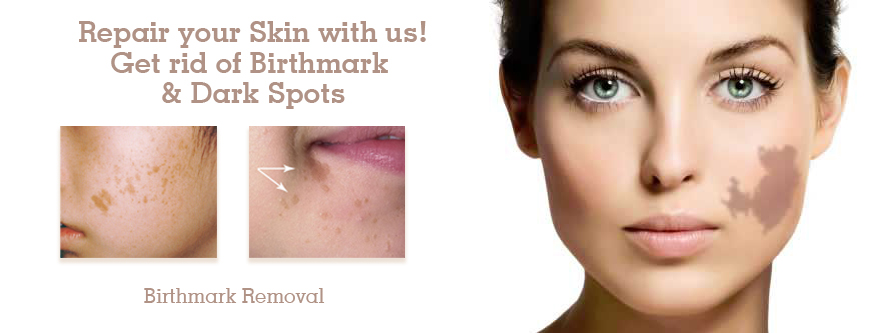Birthmark Removal Pune
 A birthmark is a discoloration on the skin that is present from the moment of birth, or shortly thereafter. They may be hereditary and they might disappear on its own .
A birthmark is a discoloration on the skin that is present from the moment of birth, or shortly thereafter. They may be hereditary and they might disappear on its own .
If they appear noticeably in areas such as the face they can affect the appearance of the individual and thus lower self-esteem levels.
Types Of Birthmarks
Pigmentation-type birthmarks
These can include various types of birthmarks including moles (congenital nevi), Coffee-cream spots, and Mongolian spots. Mole is a nonspecific term for nevus, which is a pigmented skin spot. While most moles pose no health risks, some large nevi may have cancerous effects later on during one’s life. .
Macular stains (salmon patches)
These are very thin, light pink, flat patches of discoloration.
Vascular malformations
These are caused by abnormal development of blood vessels and are almost always present from birth. Port-wine stains, a very common birthmark, are a type of vascular malformation and can be found anywhere on the body
Hemangiomas
These are lesions that develop on infants within a couple of weeks after birth. These are caused by many tiny blood vessels that are bunched together and can grow quite rapidly during the child’s first six to nine months. These are the most common tumors found in babies and usually develop around the head and neck. Some disappear within a few months after birth, while most take years before they disappear or fade.
Benefits
There are several benefits associated with laser birthmark removal. The procedure is virtually painless and will usually require no anesthetic. There will usually be a tingling sensation that can be compared to a snapping rubber band on your skin. No hospital stay will be required and the recovery period is relatively short.
Usually, any tenderness or bruising will fade within a week. The improvement of your appearance can be a boost to your self-confidence and self-esteem levels, as well. There is no age limit with laser birthmark removal.
Patient Characteristics:
In general, ideal candidates include those who are in good health, both physically and psychologically and who:
– Are realistic in expectations and understand how the procedure is performed.
– Are non-smokers or who can refrain from smoking during healing..
– Are not heavy alcohol users.
How Is Birthmark Removal Performed?
There are different ways that a birthmark can be removed, depending upon its type, size, location and other factors.
Laser Therapy
Lasers are used to treat birthmarks that are close to the surface of the skin, such as port-wine stains. This method can be performed at any age. During treatment, short bursts of laser light are aimed at the birthmark in order to shrink it or cause it to stop growing. Multiple visits may be necessary to achieve optimal results.
Surgery
This method is used when other non-surgical treatments have not worked. A hemangioma that is large, or found on an internal organ also requires surgery and general anesthesia.
Medicines
are prescribed for some of the birth mark which is mainly steroid. These medicines are helpful to treat certain types of birthmarks.
Procedure:
Laser technology uses a pulsing high-energy laser that allows for precision birthmark removal.Usually, no anesthetic is needed since the procedure is relatively painless. There should only be a tingling sensation felt during the process.
The laser will be used to lighten the birthmark’s darker tones and, in some cases, remove it altogether. This is especially true of lighter coffee-colored birthmarks. However, port-wine colored birthmarks may need more intensive treatments that will be spaced several months apart.
Treatments will take anywhere between several minutes to a few hours – depending on the severity and size of the birthmark. The treatments are done on an out-patient basis No hospital overnight stay will be needed.
You should avoid anticoagulant, anti-inflammatory medicines such as aspirin, for 2 weeks prior to treatment.
Recovery:
The recovery time for healing from birthmark removal is relatively short. Any swelling or discomfort will usually fade in about a week. You may notice that the treated area will become dark purple. This should disappear about ten days after the procedure but, in some cases, it can last for 6-8 weeks. The healing process takes about six weeks after treatment; during that time, the results of the procedure should become more evident.
You will be advised to refrain from scratching the treated area. You should also avoid direct sunlight or use a good sunscreen when going outside in the daytime.
How Much Pain Is Associated With Birthmark Removal?
This depends upon the type of procedure used. For laser therapy, patients may feel mild pain, like a rubber band snapping at the skin. Some experience a transient, mild burning sensation. An anesthetic may be given to those people sensitive to pain.
Risks Associated With Birthmark Removal:
Birthmark removal risks are minimal. In rare cases, there may be some bruising, or scabbing. Skin tone problems can also occur. These will appear as dark or light areas on the skin. Occasionally, there may be a dark patch surrounded by lighter skin.
Surgical removal of birthmarks carries the same risks associated with any surgical procedure. This includes bleeding, infection and scarring.
What Is The Cost Of Birthmark Removal?
The costs for birthmark removal vary depending on the method used and the size of the area to be treated.











